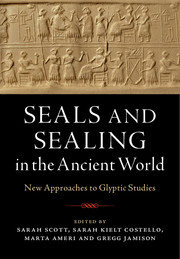 Seals and Sealing in the Ancient World
Seals and Sealing in the Ancient World Book contents
- Seals and Sealing in the Ancient World
- Seals and Sealing in the Ancient World
- Copyright page
- Contents
- Notes on Contributors
- Illustrations
- Plates
- Tables
- Acknowledgments
- Preface
- Abbreviations
- Chapter One Introduction: Small Windows, Wide Views
- Part I The Ancient Near East and Cyprus
- Chapter Two Administrative Role of Seal Imagery in the Early Bronze Age: Mesopotamian and Iranian Traders on the Plateau
- Chapter Three Slave Labor: Uruk Cylinder-Seal Imagery and Early Writing
- Chapter Four The First Female Bureaucrats: Gender and Glyptic in Third-Millennium Northern Mesopotamia
- Chapter Five Rematerializing the Early Dynastic Banquet Seal
- Chapter Six Sealing Practices in the Akkadian Period
- Chapter Seven Authenticity, Seal Recarving, and Authority in the Ancient Near East and Eastern Mediterranean
- Part II South Asia and the Gulf Region
- Part III Egypt
- Part IV Aegean
- References
- Endnotes
- Index
Chapter Four - The First Female Bureaucrats: Gender and Glyptic in Third-Millennium Northern Mesopotamia
from Part I - The Ancient Near East and Cyprus
Published online by Cambridge University Press: 24 April 2018
- Seals and Sealing in the Ancient World
- Seals and Sealing in the Ancient World
- Copyright page
- Contents
- Notes on Contributors
- Illustrations
- Plates
- Tables
- Acknowledgments
- Preface
- Abbreviations
- Chapter One Introduction: Small Windows, Wide Views
- Part I The Ancient Near East and Cyprus
- Chapter Two Administrative Role of Seal Imagery in the Early Bronze Age: Mesopotamian and Iranian Traders on the Plateau
- Chapter Three Slave Labor: Uruk Cylinder-Seal Imagery and Early Writing
- Chapter Four The First Female Bureaucrats: Gender and Glyptic in Third-Millennium Northern Mesopotamia
- Chapter Five Rematerializing the Early Dynastic Banquet Seal
- Chapter Six Sealing Practices in the Akkadian Period
- Chapter Seven Authenticity, Seal Recarving, and Authority in the Ancient Near East and Eastern Mediterranean
- Part II South Asia and the Gulf Region
- Part III Egypt
- Part IV Aegean
- References
- Endnotes
- Index
Summary
Previous efforts to understand the relationships between gender and glyptic have focused mainly either on the uses of seals as a form of female jewelry or in regard to women being the subject of iconography. The seal, however, served several functions in economy and society, not least as an administrative tool. It has often been assumed that bureaucratic control was the exclusive domain of males, in spite of frequent physical (funerary) and iconographic associations of women and glyptic. While northern Mesopotamia does not have the quality of mortuary remains seen in southern Mesopotamian “royal cemeteries,” there is a rich glyptic repertoire with ample references to gender and social hierarchy. An explicitly gendered approach to the study of this glyptic assemblage can be used to assess how gender affected bureaucratic roles in northern Mesopotamia, which can have larger implications for the role of gender in society.
- Type
- Chapter
- Information
- Seals and Sealing in the Ancient WorldCase Studies from the Near East, Egypt, the Aegean, and South Asia, pp. 54 - 67Publisher: Cambridge University PressPrint publication year: 2018
- 1
- Cited by


